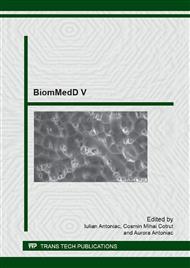[1]
C. Fischbach, Tessmar J, Lucke A, Schnell E, Schmeer G, Blunk T. Does UV irradiation affect polymer properties relevant to tissue engineering? Surf. Sci. 491 (2001) 333- 345.
DOI: 10.1016/s0039-6028(01)01297-3
Google Scholar
[2]
A. Sionkowska, Current research on the blends of natural and synthetic polymers: Review", Prog. Polym. Sci. 36 (2011) 1254-1276.
Google Scholar
[3]
H. Kaczmarek, J. Kowalonek, A. Szalla, A. Sionkowska, Surface modification of thin polymeric films by air-plasma or UV-irradiation. Surf. Sci. 507-510 (2002) 883-888.
DOI: 10.1016/s0039-6028(02)01367-5
Google Scholar
[4]
D.G. Castner, B.D. Ratner, Biomedical Surface Science: Foundations to Frontiers. Surf. Sci. 500 (2002) 28-60.
DOI: 10.1016/s0039-6028(01)01587-4
Google Scholar
[5]
C.H. Lee, A. Singla, Y. Lee, Biomedical applications of collagen. Int. J. Pharm. 221 (2001) 1- 22.
Google Scholar
[6]
K.P. Rao, Recent developments of collagen-based materials for medical applications and drug delivery systems. J. Biomater. Sci. Polym. Ed. 7 (1995) 623-631.
Google Scholar
[7]
A. Sionkowska, in: Current Topics in Polymer Research, edited by R.K. Bregg, NOVA Publishers USA (2005) 125-168.
Google Scholar
[8]
O. Hakimi, D. P. Knight, F. Vollrath, P. Vadgama, Spider and mulberry silkworm silks as compatible biomaterials, Composites: Part B 38 (2007) 324–337.
DOI: 10.1016/j.compositesb.2006.06.012
Google Scholar
[9]
D. Kaplan, W. Wade Adams, B. Farmer, C. Viney, Chapter 1, Silk: Biology, structure, properties, and genetics, Am. Chem. Soc. New York 1994.
Google Scholar
[10]
E. S. Sashina, A. M. Bochek, N. P. Novoselov, and D. A. Kirichenko, Structure and Solubility of Natural Silk Fibroin, Russ. J. Appl. Chem. 79 (2006) 869-875.
DOI: 10.1134/s1070427206060012
Google Scholar
[11]
M.H Struszczyk, Chitin and Chitosan: Part II: Applications of chitosan. Polimery 47 (2002) 396-403.
DOI: 10.14314/polimery.2002.396
Google Scholar
[12]
R. Muzzarelli, V. Baldassarre, F. Conti, P. Ferrara, G. Biagini, G. Gazzanelli, V. Vasi, Biological activity of chitosan: ultrastructural study. Biomaterials 9 (1988) 247-252.
DOI: 10.1016/0142-9612(88)90092-0
Google Scholar
[13]
N. Majeti, R. Kumar R, A review of chitin and chitosan applications. React. Funct. Polym. 46 (2000) 1-27.
Google Scholar
[14]
M. Rinaudo, Chitin and chitosan: Properties and applications. Progr. Polym. Sci. 31 (2006) 603-632.
Google Scholar
[15]
A. Sionkowska, A. Planecka, The influence of UV radiation on silk fibroin, Polym. Degrad. Stab. 96 (2011) 523-28.
DOI: 10.1016/j.polymdegradstab.2011.01.001
Google Scholar
[16]
A. Sionkowska, A. Kaminska, C.A. Miles, A.J. Bailey, The effect of UV radiation on the structure and properties of collagen, Polimery 6 (2001) 379-384.
DOI: 10.14314/polimery.2001.379
Google Scholar
[17]
C.A. Miles, A. Sionkowska, S.L. Hulin, T.J. Sims, N.C. Avery, A.J. Bailey, Identification of an intermediate state in the helix-coil degradation of collagen by ultraviolet light, Journal of Biological Chemistry 275 (2000) 33014-33018.
DOI: 10.1074/jbc.m002346200
Google Scholar
[18]
M. Wiśniewski, A. Sionkowska, H. Kaczmarek, S. Lazare, V. Tokarev, C. Belin, Spectroscopic study of a KrF excimer laser treated surface of the thin collagen films, .J. Photochem. Photobiol. Part A: Chemistry 188 (2007) 192-199.
DOI: 10.1016/j.jphotochem.2006.12.012
Google Scholar
[19]
S. Lazare, V. Tokarev, A. Sionkowska, M. Wiśniewski, Negative pressure model for surface foaming of collagen and other biopolymer films by KrF excimer laser ablation, Journal of Physics: Conference Series 59 (2007) 543-547.
DOI: 10.1088/1742-6596/59/1/116
Google Scholar
[20]
S. Lazare, A. Sionkowska, M. Zaborowicz, A. Planecka, J. Lopez, M. Dijoux, C. Loumena, N-C. Hernandez, Bombyx Mori Silk Protein Films Microprocessing with a Nanosecond Ultraviolet Laser and a Femtosecond Laser Workstation: Theory and Experiments, Applied Physics A, 106 (2012) 67-77.
DOI: 10.1007/s00339-011-6639-y
Google Scholar


